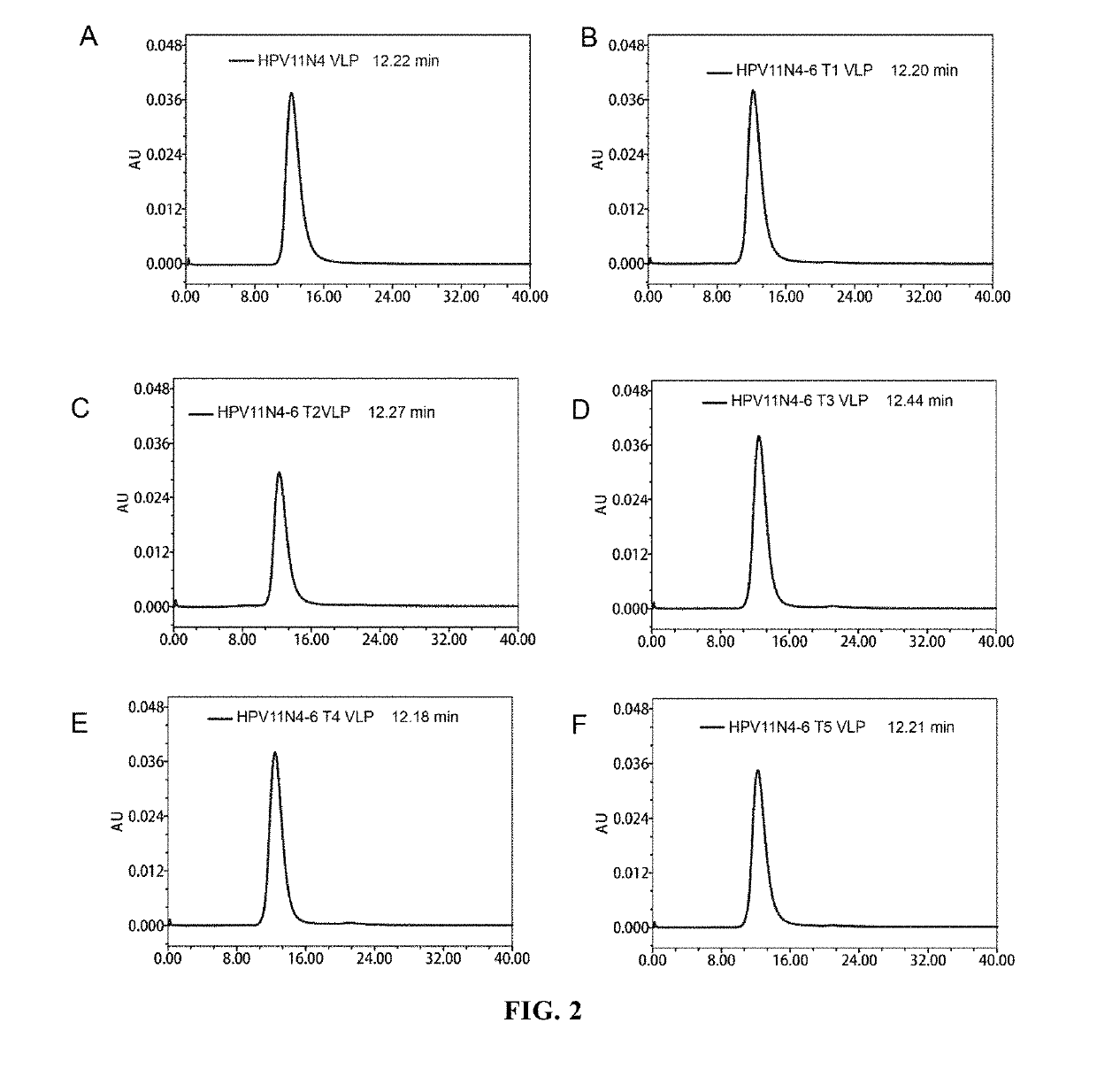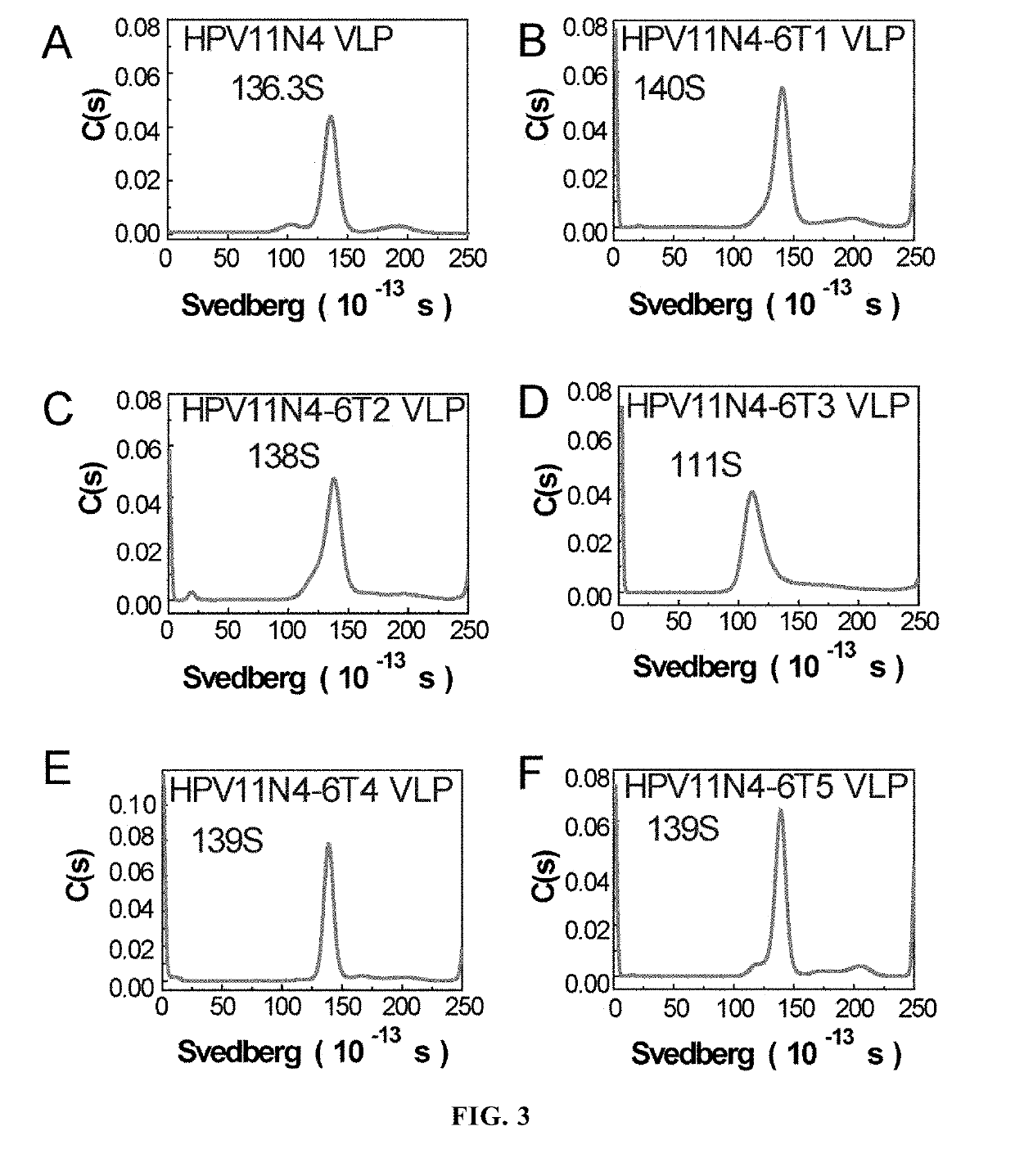Mutant of L1 protein of human papillomavirus type 11
a human papillomavirus and mutated protein technology, applied in the field of molecular virology and immunology, can solve the problems of increasing the production cost of hpv vaccines, limited protection range of existing hpv vaccines,
- Summary
- Abstract
- Description
- Claims
- Application Information
AI Technical Summary
Benefits of technology
Problems solved by technology
Method used
Image
Examples
example 1
Expression and Purification of the Mutated HPV11 L1 Proteins
[0084]Construction of Expression Vectors
[0085]An expression vector encoding the mutated HPV11 L1 protein (H11N4-6T1) comprising a specific segment from HPV6 L1 protein was constructed by PCR for multi-site mutagenesis, wherein the initial template used was the plasmid pTO-T7-HPV11N4C (encoding the HPV11 L1 protein having 4 amino acids truncated at N-terminal; abbreviated as 11L1N4 in Table 2). The templates and primers for each PCR were shown in Table 2, and the amplification conditions for PCR were as followed: denaturation at 94° C. for 10 min; 25 cycles (denaturation at 94° C. for 50 sec, annealing at a given temperature for a certain period of time, and extension at 72° C. for 7.5 min); and finally extension at 72° C. for 10 min. The sequences of the PCR primers used were listed in Table 3.
[0086]To the amplification product (50 μL), 2 μL restriction endonuclease DpnI was added, and the resultant mixture was incubated at...
example 2
Assembly of HPV Virus-Like Particles and Morphological Test of Particles
[0107]Assembly of HPV Virus-Like Particles
[0108]A given volume (about 2 ml) of the protein H11N4-6T1, H11N4-6T2, H11N4-6T3, H11N4-6T4 or H11N4-6T5, was dialyzed to (1) 2 L storage buffer (20 mM sodium phosphate buffer pH 6.5, 0.5 M NaCl); (2) 2 L renaturation buffer (50 mM sodium phosphate buffer pH 6.0, 2 mM CaCl2, 2 mM MgCl2, 0.5 M NaCl); and (3) 20 mM sodium phosphate buffer pH 7.0, 0.5 M NaCl, successively. The dialysis was performed in each of the three buffers for 12 h.
[0109]By similar methods, the HPV11N4 and HPV6N5 protein were assembled into HPV11N4 VLP and HPV6N5 VLP, respectively.
[0110]Molecular Sieve Chromatographic Analysis
[0111]The dialyzed sample was subjected to molecular sieve chromatographic analysis by 1120 Compact LC High Performance Liquid Chromatographic System (Agilent Technologies), wherein the analytical column used was TSK Gel PW5000xl 7.8×300 mm. The analysis results were shown in FIGS...
example 3
Evaluation of Thermostability of Virus-Like Particles
[0116]The VLPs formed by HPV11N4, H11N4-6T1, H11N4-6T2, H11N4-6T3, H11N4-6T4 and H11N4-6T5 were evaluated for their thermostability by using differential scanning calorimeter VP Capillary DSC purchased from GE Company (i.e. the original MicroCal Co.), wherein the storage buffer for the protein was used as control, and the proteins were scanned at a heating rate of 1.5° C. / min within a temperature range of 10° C.-90° C. The detection results were shown in FIGS. 5A-5F. The results showed that all these VLPs formed by the proteins had very high thermostability.
PUM
| Property | Measurement | Unit |
|---|---|---|
| radius | aaaaa | aaaaa |
| temperature | aaaaa | aaaaa |
| temperature | aaaaa | aaaaa |
Abstract
Description
Claims
Application Information
 Login to View More
Login to View More - R&D
- Intellectual Property
- Life Sciences
- Materials
- Tech Scout
- Unparalleled Data Quality
- Higher Quality Content
- 60% Fewer Hallucinations
Browse by: Latest US Patents, China's latest patents, Technical Efficacy Thesaurus, Application Domain, Technology Topic, Popular Technical Reports.
© 2025 PatSnap. All rights reserved.Legal|Privacy policy|Modern Slavery Act Transparency Statement|Sitemap|About US| Contact US: help@patsnap.com



